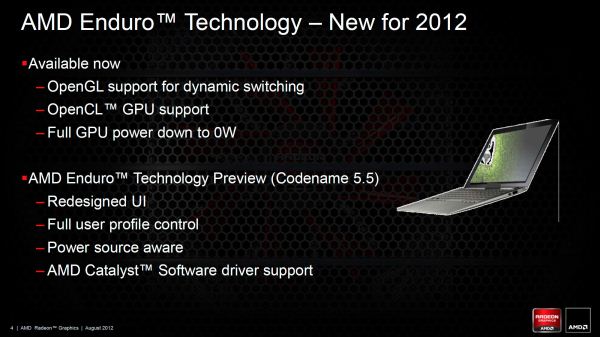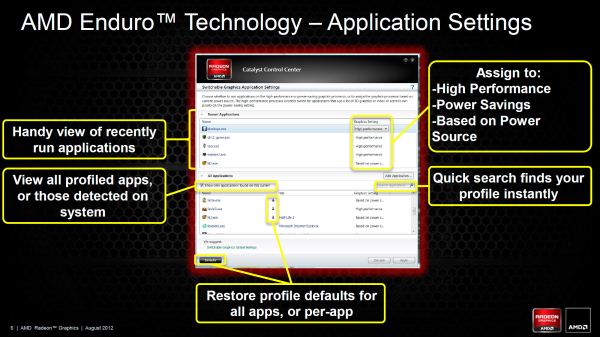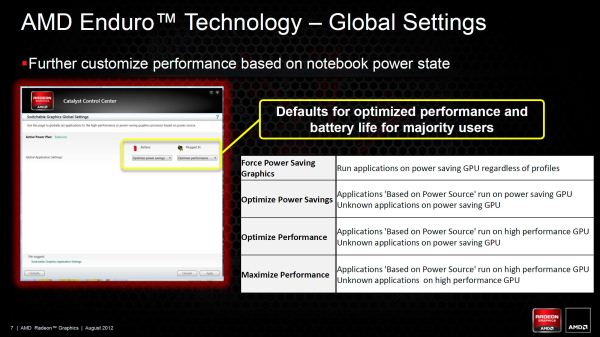AMD’s Enduro Switchable Graphics Levels Up
by Jarred Walton on September 6, 2012 3:00 AM ESTNew for Mid-2012: “Enduro 5.5” Enhancements
When AMD created the Enduro brand, they were really almost where we wanted them. They had dynamic switching with support for most of the latest games and applications, and when it worked properly it would be difficult to tell if you were using an NVIDIA or an AMD dGPU. The problem was when things didn’t work and you had to go into the drivers, and there were several problems. OpenGL support was totally out, many of the latest games were also missing default profiles (and sometimes wouldn’t let you properly specify the correct GPU), the UI was obtrusive and sometimes hard to use (particularly for power users), and the drivers were dictated by the laptop manufacturers and were usually months old at launch and never updated.
While the UI seems like a minor thing to fix—I would have thought one or two months to improve the UI would have been sufficient—at least prior to the forthcoming update it remained largely unchanged. The lack of AMD-provided driver updates was really the major issue, because everything else could potentially be fixed with new drivers and you would never know. The other areas like OpenGL/OpenCL and support for various games/applications should improve over time as well, provided you can get drivers. That brings us to the upcoming Enduro release, scheduled to come out sometime this month or next. Officially it’s still just Enduro, but to help differentiate between the previous Enduro release and the upcoming release we’ll sometimes refer to the new version as “Enduro 5.5”.
The biggest news with the latest iteration of Enduro is that AMD is planning to make universal reference drivers available for all the Enduro laptops. It’s not clear precisely what that means, but potentially any laptop with Dynamic Switchable Graphics or later (e.g. PX4.0 and later) would be supported by AMD’s “reference” drivers. That’s huge, and if AMD can deliver it will assuage most of our concerns with their hardware/software. Hopefully none of the OEMs get bent out of shape or refuse to allow support, which is a problem we've seen in the past. We should see the first public release in the next month or two, and then another release somewhere in the November/December timeframe.
Besides the availability of driver updates, the UI also receives a much needed overhaul, providing both regular and power users all the options they’re likely to need as far as control of graphics switching is concerned. Open up the switchable graphics options and the top section remains largely the same, but the bottom now allows you to see all application profiles (or just the profiles for detected applications). There’s also a quick search option that works both on executable name and application/game name (e.g. HL2.exe or Half-Life 2 will both find the profile for Half-Life 2). From either list (recently used apps up top, or all apps at the bottom), you can set the GPU profile.
Where previously there were two settings (three if you count “Not Assigned”), there are now three options. As before, “Power saving” sets an application to run on the integrated graphics while “High performance” sets an application to run on the discrete GPU. The new third option is “Based on power source”, which does precisely what you’d expect: plug the laptop in and the apps with this setting will run on the discrete GPU; switch to battery power and they’ll run on the integrated graphics. For many users, everything could default to “Based on power source” and they would be happy, but certainly there will be times where you’re running on battery power but still want to use the dGPU and the drivers give you that option. Should things get squirrelly, you can also reset applications individually or globally to their default settings. It’s worth noting that the power state aware setting is something that NVIDIA currently does not implement, requiring manual intervention if you wish to override your normal settings—though how often people are using apps that require the dGPU while on battery power is something we could debate.
Besides the individual application profiles, AMD is also adding a new area to their drivers: Switchable Graphics Global Settings. This is something you could sort of get before with some laptops, but previously it involved changing from Dynamic Switchable Graphics to manual switching (i.e. switching based on power source) and then forcing the laptop into High Performance or Power Saving mode if you wanted to be low power while plugged in or high power while unplugged. That was clunky and at least in the case of the Sony VAIO C we tested it caused flickering similar to the old switchable graphics, with the dGPU drivers getting unloaded and iGPU drivers getting loaded (or vice versa), with some work behind the scenes copying context from one GPU to the other. It worked but it wasn’t elegant; perhaps more importantly, Microsoft doesn’t want anyone doing this with Windows 8 and thus new laptops won’t be able to get a Windows 8 sticker if they use this method of switching (which basically means no new laptops will do this). To make up for the loss of this functionality (which some people still prefer), AMD has added a new global settings section.
Unlike the individual application profiles, the global settings gives you four options each for Battery and Plugged In. The top two options are similar in most cases and will generally run most applications on the iGPU, and the same goes for the bottom two modes where you’ll run most apps on the dGPU. The difference is that “Force Power Saving GPU” will run all applications (regardless of what the custom profile says) on the iGPU, essentially disabling the dGPU completely. “Optimize Power Savings” in contrast will run all unknown or “Based on power source” applications on the iGPU while respecting the application profiles where they exist. “Optimize Performance” is sort of the reverse of that, running all “Based on power source” applications on the dGPU while leaving unknown applications on the iGPU. Finally, the “Maximize Performance” option runs all unknown and “Based on power source” applications on the dGPU—but applications specifically set to use the iGPU will continue to do so.
The reason for that last discrepancy (e.g. why you can’t simply run everything on the dGPU and forget about the iGPU) is that certain tools have to run on the iGPU. Intel’s drivers are one example—loading those up on the dGPU would cause problems. Intel’s WiDi is the only other I could find on my particular Clevo notebook. We were told that some of the laptop utilities like an overlay showing percentage of brightness, volume, etc. may also need to run on the iGPU. Besides the few applications that have to run on the iGPU, any applications that are set to Power Saving will continue to use the iGPU—and this makes sense as there are a lot of applications that can be set to run on iGPU/dGPU that have no need of higher performance GPU options (several anti-virus utilities come to mind, where they're starting to create a 3D context for their UI). The net result is that other than a few specific applications where the profile will exist and be locked to the iGPU, with no option to change to dGPU, everything else that uses higher function graphics can be customized to run on a specific GPU, but if you set something to iGPU presumably you want it to always run there—otherwise you would use the “Based on power source” setting.
A full set of screenshots from all the driver screens is available in the gallery below if you’re interested.
One final topic worth discussing is Windows 8. Certainly there are owners of existing laptops with switchable graphics that are wondering if they can upgrade to Windows 8 and what will happen. We’ll have to see how this actually plays out, but it sounds like the earlier versions of PowerXpress (3.0 and earlier) will probably get support with one driver bundled with Windows 8, and that may be it—but there’s always the possibility for the laptop OEMs to release their own updates, or for AMD to roll out additional drivers for older laptops. The potential for PowerXpress 4.0 and later laptops to get regular driver updates (for Windows Vista/7/8) is there, but until we actually start seeing public driver releases AMD hasn’t fully committed to supporting all of those laptops.



















200 Comments
View All Comments
krumme - Thursday, September 6, 2012 - link
Jarred you are pissed at AMD, and it shows everywhere :)AMD have CPU and manufactoring competence inhouse that should easily see all the nessesary steps involved in designing a solution. The competence base is broader than NV. For this kind of problem, thats is an advantage, as you have the competence base to adress the situation.
But if its not brought into play its of no use. But thats a management problem. This is not an engineering problem.
They were designing gfx for the desktop market, While they should enlarge portability and entertainment. And it shows for the rest of the portfolio. We now why rr is the new boss.
edryr - Thursday, September 6, 2012 - link
This article is just pathetic.Why aren't there any mention of underutilization on all gcn based gpu using enduro ? Why no mention of any amd's movements like deleting all posts regarding thoses issues ? Why no comment on games runing smoother on 570m because of lack of skill from amd ?
Pathetic...
coder543 - Thursday, September 6, 2012 - link
conspiracy theorist much?Montage - Thursday, September 6, 2012 - link
Sager (a Clevo reseller) made a thread in Notebook Review where they admitted the issue and wanted the community to participate in solving the issue by logging the underutilization issues. Many people spent a lot of time to collect potentially valuable information regarding the issue.Suddenly Sager informs that they have been requested, by AMD, to ask the NBR moderators to remove the thread. Sager hasn't mentioned the thread since and now their stance it that there IS NO PROBLEM.
You got to admit that this episode is rather weird. Also, AMD hasn't made any official announcements, comments, remarks etc. regarding the enduro issues. Also, one thread concerning the issue was closed on AMD's own forums, supposedly due to offensive language or something, though the comments on the thread stayd both civilized and relatively polite.
The enduro issues affect all current generation 7000M series AMD cards.
kiol - Thursday, September 6, 2012 - link
Civilization 5 @ 26 FPS, Battlefield 3 @ 36FPS are not "very respectable" frame rates as you put it, specially when you get better frame rates from previous generation cards. You know that AnandtechThis whole article seems like an attempt from AMD to hide the whole issue or make it seem less severe.
They have already closed threads and censor resellers from even talking about it.
They say drivers aren’t fully optimized for performance AND particularly with the 7970M
AMD's new generation mobile flagship graphics card is not optimized for performance??? so which one is it?
very disappointing AMD, sorry you don't pay near $2000 for a laptop to get "respectable performance" and a hope for a better drivers.
by the way the same problem exists with Alienware, fortunately they are able to completely disable Enduro "technology"
but as it is Enduro effectively downgrades and cripples AMD's graphic cards. So
JarredWalton - Thursday, September 6, 2012 - link
Civ5 performance is low (still), but BF3 at 36FPS on 1080p Ultra settings is hardly something to complain about. Really, HD 7970M is more of a competitor to GTX 580M (should be slightly faster) whereas the 680M is the latest and greatest. For our full set of games (and there will be more in the full review), here's what I've got at our Enthusiast (max) settings and 1080p. (Note that NVIDIA 680M numbers are with older 304 series drivers; I'll be updating to 306 series before final review. The 580M are with even older drivers, but I don't have that system so I can't update to the latest drivers--and there's a real chance the latest drivers could drop performance in some titles on Fermi.)Batman: Arkham City
7970M: 52
680M: 83
580M: 49
Battlefield 3
7970M: 36.1
680M: 42.7
580M: 33.1
Civilization V
7970M: 26.2
680M: 53.4
580M: 41.7
DiRT 3
7970M: 61.1
680M: 68.3
580M: 43.8
Portal 2
7970M: 115.3
680M: 160.5
580M: 104.8
Skyrim
7970M: 47.2
680M: 64.0
580M: 51.8
Total War: Shogun 2 (900p High, as Very High wouldn't run on 7970M)
7970M: 78.6
680M: 120.9
580M: 90.1
Against GTX 680M, right now it's no contest, but that's not really surprising. Against 580M, though, things are close -- and by close, I mean AMD wins by a fairly large margin in some titles like DiRT 3, loses by a large margin in other titles like Civ5, and it's relatively close in the others.
arcticjoe - Thursday, September 6, 2012 - link
Problem with those numbers is that when you put 7970m in a system without Enduro support (like old clevo 1x0HM series) it performs pretty much on par with 680m, sometimes even beating it.JarredWalton - Thursday, September 6, 2012 - link
I experienced similar issues with Optimus early on, particularly in games where you would see higher frame rates. My assumption at the time was that copying large amounts of data over the PCIe bus may have been part of the problem. (60 FPS at 1080p means roughly 500MB of data every second, just to update the display contents.) That might not seem like much, but where PCIe 3.0 can in theory do 16GB/s, real-world I would expect max utilization to be lower, and .5GBps is still a lot of bandwidth with everything else going on.Enduro could be having similar issues, and there's certainly overhead relative to doing things natively. The question is: can the issues be addressed with driver updates? For most items, I would say definitely, and that's why this article was done. I could have titled it: "AMD Is Finally Committing to Regular Driver Updates for Enduro" and left the content blank and maybe people would have understood the point a bit better. It's not that Enduro IS fixed; it's that Enduro CAN be fixed -- provided AMD keeps updating the drivers.
If you go back three years and read what I was saying about laptops with discrete GPUs, I repeatedly castigated NVIDIA and AMD for not doing regular mobile driver updates, essentially stating that we (AnandTech) could not recommend any "gaming laptop" unless there was a guarantee of regular driver updates. Starting in Sept/Oct, AMD is finally making that commitment -- something NVIDIA did with their Verde program and Optimus over two years ago.
Montage - Thursday, September 6, 2012 - link
In BF3 the fps drops below 20 at times (see the link for screenshot). This does not happen when Enduro is turned off. Also in Witcher 1, for example, the fps suddenly drops very low and causes stuttering, and again, not when Enduro is turned off. If Clevo's could only turn the thing off.http://imageshack.us/f/716/bf320120727225130242.jp...
Woodchuck2000 - Thursday, September 6, 2012 - link
I have a Clevo P150EM with an Ivy Bridge CPU and a 7970M. Running the release preview of Windows 8, I can't find an installable driver from the AMD website which enables 'Enduro'. Predictably, there are drivers for desktop GPUs. I don't understand why it's so hard to provide laptop drivers in the same package, particularly for laptops with a generic MXM card like mine.Enduro works okay on Windows 7, but the user interface is extremely clunky and obtrusive. Is there any news on when AMD's new drivers will be available to the rest of us?